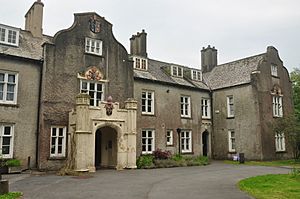Carmarthenshire County Museum facts for kids
| Amgueddfa Sir Gaerfyrddin | |

Exterior view of the Carmarthenshire County Museum.
|
|
| Lua error in Module:Location_map at line 420: attempt to index field 'wikibase' (a nil value). | |
| Established | 1908 |
|---|---|
| Location | Abergwili, Carmarthen, Wales, United Kingdom |
| Type | Local Museum |
| Visitors | 12,889 (2009) |
| Owner | Carmarthenshire County Council |
| Nearest car park | On site (no charge) |
The Carmarthenshire County Museum is a fun place to visit in Carmarthen, Carmarthenshire, Wales. It is a museum that tells the amazing story of the county's past.
Contents
Where to Find the Museum
The Carmarthenshire County Museum is located in Abergwili, a village near Carmarthen. Its full address is SA31 2JG. The museum is looked after by the Carmarthenshire County Council.
A Building Full of History
The museum building itself is very old and has a long history. It started as a college for priests way back in the 1280s. Later, from 1542 to 1974, it was the home of the Bishop of St Davids.
This building is also famous for an important event. In 1567, the New Testament (part of the Bible) and the Book of Common Prayer were first translated into the Welsh language right here. This happened when Bishop Richard Davies was living in the palace.
What You Can See at the Museum
The museum shows the rich history of Carmarthenshire through many different items. You can see old artifacts, paintings, and portraits.
Special Collections
The museum has some special collections that you might find interesting:
- Welsh Furniture and Clothes: There is a great collection of old Welsh furniture and traditional costumes.
- Victorian Schoolroom: You can step back in time and see what a village schoolroom looked like during the Victorian era.
- Farming History: Learn about the county's farming and agricultural past. There are items related to how people used to farm the land.
- World War II Exhibition: Discover what life was like on the "home front" in Carmarthenshire during World War II. This shows how people lived and helped during the war.

